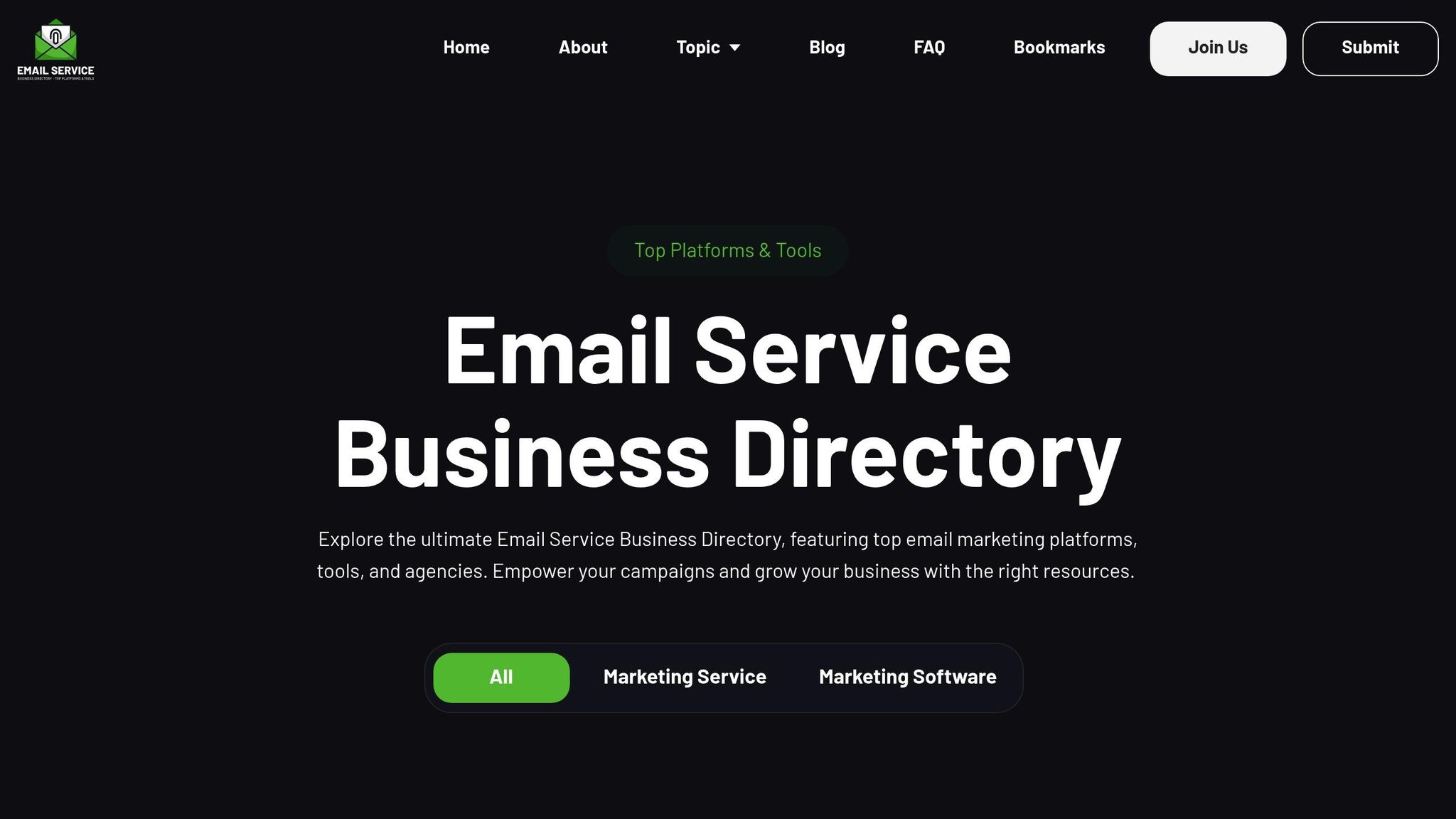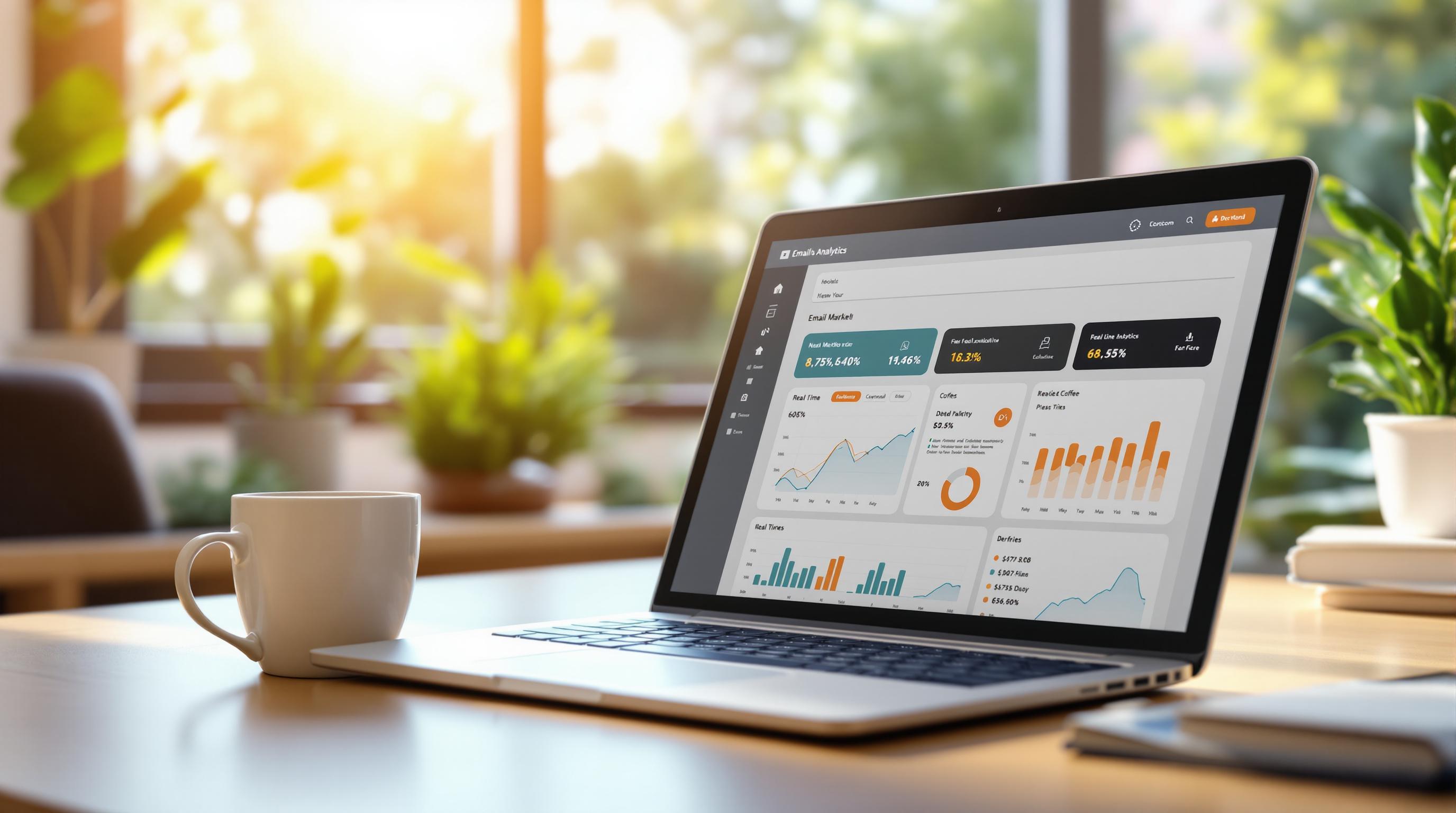Clickstream data is a digital record of user activity on websites or apps, capturing actions like clicks, navigation paths, and session lengths. It provides insights into user behavior, even for anonymous visitors, enabling marketers to create more personalized email campaigns. By using behavioral triggers - emails sent automatically based on user actions - you can address common challenges like cart abandonment, low engagement, and incomplete data.
Key takeaways:
- What it is: Clickstream data tracks user actions online, offering real-time insights into behavior without relying on personal information.
- Why it matters: Behavioral triggers, powered by clickstream data, allow you to send timely, action-based emails that increase engagement and conversions.
- Common uses: Cart abandonment emails, product recommendations, and re-engagement campaigns for inactive users.
- Challenges: Integration complexity, privacy compliance, high costs, and risks of over-personalization.
To implement this effectively, use tools that integrate clickstream data and automate triggers. Platforms listed in the Email Service Business Directory can help you find the right solution for your needs.
Common Email Marketing Engagement Problems
Email marketers often encounter challenges that hold their campaigns back from achieving maximum impact. These hurdles frequently stem from incomplete data, fragmented customer insights, and the need to adhere to strict privacy regulations. Addressing these problems starts with leveraging clickstream data analysis to uncover actionable insights.
Incomplete Data and Missed Opportunities
One of the biggest obstacles is dealing with incomplete data. When customer information is scattered across different systems or missing key details, creating personalized and timely emails becomes a challenge. For example, without knowing which pages a visitor browses, how long they stay, or where they face issues, it’s nearly impossible to craft messages that truly connect.
Clickstream data fills these gaps by offering a clearer view of user behavior. This data enables marketers to set up precise behavioral triggers, such as sending cart abandonment emails or personalized product recommendations. However, with 90% of website visitors remaining anonymous, incomplete data often results in missed chances to engage a large portion of your audience. The outcome? Lost opportunities to follow up and, ultimately, lower conversion rates.
Low Conversion Rates and Abandoned Carts
Cart abandonment is a persistent issue, with rates reaching as high as 69.57%. Many of these abandoned carts are linked to friction points in the shopping experience, like confusing checkout processes or missing information. Without clickstream data to pinpoint where users hesitate or drop off, marketers are left guessing about the root causes.
By utilizing real-time clickstream data, marketers can identify these friction points and act on them. For instance, tracking where users pause or backtrack can reveal critical insights. Companies that incorporate this data into their behavioral triggers have reported email open rate increases of 20-30% and noticeable reductions in cart abandonment.
Privacy and Legal Requirements
In the U.S., adhering to privacy regulations like the CAN-SPAM Act and CCPA is essential for email marketers. These laws require that clickstream data remain anonymized and non-personally identifiable (non-PII). This ensures compliance while still allowing marketers to analyze user behavior effectively.
Setting Up Behavioral Triggers with Clickstream Data
Now that the challenges are clear, let’s dive into the practical steps for using clickstream data to set up behavioral triggers. This process revolves around three main components: tracking customer journeys, defining trigger events, and leveraging real-time data to deliver personalized content.
Tracking Customer Journey Paths
The foundation of effective behavioral triggers lies in understanding how users navigate your website. Clickstream data offers detailed insights into user behavior, helping you map out journey paths that guide your trigger strategies.
Start by using analytics tools or tracking scripts to gather crucial data like timestamps, page URLs, referrer information, and session identifiers. This data uncovers behavioral patterns that might otherwise go unnoticed. For example, if a user visits a product page multiple times in a short period, they’re likely showing strong purchase intent but may need a little extra encouragement.
Pay attention to key moments when users display interest or hesitation. These could include actions like repeatedly viewing a product, starting but not completing the checkout process, or spending a lot of time on specific pages. By analyzing these patterns, you can identify the best opportunities to engage users - whether through targeted emails, helpful information, or social proof. These insights will help you define the trigger events that can power automated email campaigns.
Creating Trigger Events
Once you’ve mapped out the customer journey, the next step is to turn those insights into actionable trigger events. The most effective triggers focus on high-intent behaviors, such as cart abandonment, repeat visits, or inactivity.
- Cart abandonment triggers: Set criteria for when a user adds items to their cart but doesn’t complete the purchase. Studies show that emails triggered by these actions can recover 10-15% of abandoned carts.
- Repeat visit triggers: These are ideal for users who return to a product page multiple times within a short period. This behavior often signals serious consideration, making it a great time to send personalized offers or additional product details. For example, an e-commerce retailer identified users who viewed a product three times in 48 hours without purchasing. They sent personalized emails with a limited-time discount, boosting conversion rates by 25% for that segment.
- Inactivity triggers: Designed for users who initially engage but then disappear, these triggers can re-engage potential customers. For instance, if someone browses several products but doesn’t return within a set timeframe, an email can remind them of what they were exploring. Timing is critical here - too soon feels intrusive, while waiting too long risks losing the opportunity altogether.
Real-Time Data for Personalized Content
After defining your trigger events, real-time data takes personalization to the next level by enabling immediate, relevant responses. Behavioral triggers powered by clickstream data allow you to send hyper-specific emails based on the exact products or pages a user just interacted with.
Using AI and machine learning, you can dynamically predict product recommendations, tailor messaging, and optimize follow-up timing. This approach has been shown to improve conversion rates by 10-20%.
Real-time data also supports in-session marketing strategies. For example, AI can analyze a user’s behavior in real time and predict their intent, triggering personalized experiences before they leave your site. This might include targeted pop-ups, adjusted product recommendations, or preparing email sequences based on their browsing activity.
Additionally, integrating real-time data across channels - like email, social media, and paid ads - creates a unified view of the customer journey. This allows for more sophisticated trigger strategies that account for the full range of user interactions. Aligning these real-time actions with your broader email marketing goals can significantly enhance engagement and drive conversions.
Benefits and Drawbacks of Clickstream Behavioral Triggers
Behavioral triggers can significantly impact engagement and conversions, but they also come with their own set of challenges. Clickstream behavioral triggers, in particular, are a powerful tool for improving email marketing performance. However, marketers need to carefully navigate technical hurdles and privacy concerns to make the most of them.
Benefits of Behavioral Triggers
Clickstream behavioral triggers allow marketers to send emails tailored to users’ real-time actions, making them far more engaging than generic messages. This personalization often leads to higher open and click-through rates.
Another major advantage is improved conversion rates. For instance, some e-commerce businesses have used clickstream data to identify users who abandoned their shopping carts. By sending timely follow-up emails, they’ve seen a 15% increase in recovered sales. Acting quickly keeps potential customers engaged while their interest is still fresh.
Clickstream data also enables deeper audience segmentation. Instead of grouping users by basic demographics like age or location, marketers can segment them based on their actual behavior. This leads to highly targeted messaging that feels more relevant to each individual.
Additionally, this approach enhances the user experience. Emails that reference recently viewed products or offer assistance during a tricky process can feel genuinely helpful. What’s more, clickstream data can target even anonymous visitors - about 90% of site traffic - without relying on personal data.
These benefits combine to make email marketing more timely, relevant, and effective.
Challenges and Limitations
Despite its advantages, clickstream behavioral triggers come with challenges that marketers need to address:
- Integration complexity: Combining clickstream data with existing email platforms and CRM systems requires a robust technical setup, which can be daunting.
- Privacy concerns: While clickstream data doesn’t rely on personal identifiers, compliance with privacy laws like the California Consumer Privacy Act (CCPA) is still essential.
- High costs and learning curves: Advanced analytics tools needed for clickstream data often come with hefty price tags and require significant expertise to use effectively.
- Data accuracy issues: If tracking isn’t properly configured or users employ ad blockers, the data may be incomplete or inaccurate, leading to missed opportunities or irrelevant triggers.
- Over-personalization risks: Sending too many triggered emails can overwhelm users and harm engagement.
Benefits vs. Limitations Comparison
| Benefits | Limitations |
|---|---|
| Increased engagement through personalized emails | Complex integration requiring technical expertise |
| Higher conversion rates from timely follow-ups | Privacy concerns and regulatory compliance challenges |
| Deeper behavioral segmentation for targeted messaging | High costs and steep learning curves for analytics tools |
| Better user experience with relevant content | Risks of incomplete or inaccurate data |
| Ability to target anonymous visitors | Over-personalization leading to email fatigue |
| Real-time responsiveness to user actions | - |
The effectiveness of clickstream behavioral triggers depends on balancing these benefits against the challenges. Success requires thoughtful planning, a solid technical foundation, and a clear understanding of your business goals.
sbb-itb-6e7333f
Using Email Service Business Directory for Solutions

Once you've tapped into the potential of clickstream data for real-time behavioral triggers, the next challenge is finding the right tools to bring your strategy to life. That’s where the Email Service Business Directory steps in. This curated resource simplifies the process of identifying email marketing platforms that excel in advanced behavioral triggers.
Email Service Business Directory Features
The directory highlights platforms equipped with essential tools like automation, detailed analytics, CRM integration, and omnichannel capabilities - all of which are crucial for leveraging clickstream data effectively. These features empower marketers to track user behavior, create audience segments based on real actions, and automate personalized email responses when specific triggers - like cart abandonment or prolonged browsing - are detected.
Platforms featured in the directory support real-time clickstream processing and advanced user journey mapping. This means you can instantly set up triggers for common scenarios, such as sending follow-up emails after a cart is abandoned or re-engaging users whose activity has declined. Additionally, many platforms allow for custom trigger creation, giving you the flexibility to align automation with your unique business goals.
Beyond basic demographics, these platforms also offer behavior-based segmentation and predictive analytics, enabling highly relevant and impactful campaigns.
Finding the Right Platform for Your Campaigns
The directory makes it easy to filter and compare platforms based on their clickstream tracking capabilities, trigger options, and personalization tools. For instance, if abandoned cart recovery or product recommendations are your focus, you can narrow your search to platforms that specialize in these features. These tools can automatically send tailored emails to re-engage customers or suggest items they might love.
For lead nurturing, explore platforms that track multi-touch behavior and assign engagement scores to prospects. Look for solutions that activate nurturing sequences when someone downloads content, visits key pages like pricing, or spends time researching your offerings.
If you’re a B2B marketer, the directory can guide you toward platforms designed for longer sales cycles and complex buying processes. These solutions track interactions across multiple decision-makers and deliver content tailored to each stage of the buyer's journey.
To get the most out of the directory, start by defining your campaign objectives - whether it’s boosting conversions, recovering lost sales, or nurturing leads. Use the directory’s search and filter tools to find platforms with the automation and clickstream features you need. Carefully review platform profiles for their integration options, pricing, and user feedback to ensure they align with your budget and existing tools.
Directory Advantages for Email Marketers
The effectiveness of behavioral triggers depends heavily on the platform you choose. The Email Service Business Directory offers several advantages, making it a valuable resource for email marketers.
One major benefit is the time it saves. Instead of spending weeks researching and testing platforms, you can quickly compare their features side by side. The directory provides transparent details on each platform’s automation tools, analytics, and integrations, helping you make faster, informed decisions.
It also helps you avoid costly trial-and-error scenarios. With user reviews and expert ratings, you gain insights into how platforms perform in real-world situations, reducing the risk of investing in a solution that doesn’t meet your needs.
For those concerned about privacy and compliance, the directory highlights platforms that adhere to major regulations like GDPR and CCPA. You can filter for providers with strong privacy credentials, ensuring your use of clickstream data stays within legal boundaries.
Finally, the directory offers access to niche solutions for specialized needs. Whether you’re looking for advanced behavioral scoring, complex trigger workflows, or industry-specific integrations, the curated selection helps you discover platforms that might otherwise go unnoticed in a general search.
Key Points and Next Steps
Clickstream Data Main Benefits
Clickstream data offers real-time insights into every user action - tracking clicks, navigation paths, and interactions - to create emails that are both timely and tailored to actual user behavior. This level of detail allows marketers to craft campaigns based on what users actually do, rather than relying on assumptions.
The real advantage lies in the timing and relevance of these messages. For instance, if a customer spends 10 minutes browsing winter coats but doesn’t make a purchase, you can send a follow-up email with coat recommendations within hours. Even visitors who haven’t shared personal details through your CRM can be targeted effectively through this approach.
Brands that use clickstream-driven behavioral triggers report conversion rate increases of 10-20% after refining their user journeys and focusing on high-intent audiences. This data helps identify subtle pain points - like customers revisiting the same product page without buying - so you can intervene at the perfect time. These real-time insights make behavioral triggers a powerful tool for delivering highly relevant emails.
Why Behavioral Triggers Matter
Behavioral triggers take the power of clickstream data to the next level by ensuring your emails reach customers at the exact right moment. Unlike traditional campaigns that rely on scheduled sends or basic demographics, these triggers react to user actions in real time, capturing key opportunities for engagement.
This shift toward real-time marketing marks a major evolution in how brands connect with their audiences. Instead of relying on outdated or batch-processed data, behavioral triggers respond instantly to user behavior. The result? A customer experience that feels more like personalized assistance and less like typical marketing.
By ensuring your emails are contextually relevant, behavioral triggers drive higher engagement. Whether someone abandons their cart, browses specific categories, or shows signs of losing interest, these triggers deliver content that speaks directly to their current needs and preferences.
Explore the Directory for Your Needs
To make the most of clickstream-powered behavioral triggers, selecting the right email marketing platform is essential. The Email Service Business Directory simplifies this process by offering curated comparisons of platforms designed for advanced automation and behavioral triggers.
Start by clarifying your campaign objectives - whether you’re aiming to recover abandoned carts, nurture leads, or re-engage inactive customers. The directory’s search and filter tools make it easy to find platforms that support real-time clickstream integration, custom trigger creation, and compliance with privacy laws.
For businesses prioritizing privacy and compliance, the directory highlights platforms that meet major regulations like GDPR and CCPA. This ensures you can leverage clickstream data while staying within legal boundaries, all without sacrificing personalization.
Whether you’re a small business seeking basic automation or an enterprise looking for advanced behavioral workflows, the directory helps you find the ideal platform. Use its filtering tools to pinpoint the perfect solution and start improving your campaign performance right away.
FAQs
How can clickstream data help enhance email marketing campaigns?
Clickstream data offers a powerful way to refine email marketing efforts through behavioral triggers. These triggers are automated actions that respond to user activity - like visiting particular pages or leaving items in a shopping cart. By tapping into this data, marketers can craft personalized, timely emails that align with a customer’s interests, boosting engagement and driving more conversions.
For businesses aiming to elevate their email marketing strategies, choosing the right tools and platforms is key. The right solution simplifies the integration of clickstream data, helping create focused campaigns that deliver better outcomes.
What challenges can arise when using clickstream data to set up behavioral triggers in email marketing?
Implementing behavioral triggers with clickstream data isn’t without its hurdles. One of the main challenges is managing data complexity. Clickstream data often involves massive amounts of information, and making sense of it requires advanced tools and skilled analysts. Without the right resources, it can feel like trying to find a needle in a haystack.
Another issue is ensuring data accuracy. If the data you’re working with is incomplete or riddled with errors, your triggers might miss the mark, leading to poorly targeted campaigns that fail to resonate with your audience.
Then there’s the matter of privacy and compliance. Regulations like GDPR and CCPA demand that businesses handle user data carefully and transparently. Meeting these requirements isn’t just about checking boxes - it often means rethinking how data is collected, stored, and used, which can complicate implementation.
Finally, there’s the challenge of integration. Getting clickstream data to work seamlessly with your existing email marketing platforms and workflows often requires technical tweaks or even custom solutions. For teams with limited resources, this can be a heavy lift, both in terms of time and effort.
How can the Email Service Business Directory help me choose the best platform for using clickstream data in email marketing?
The Email Service Business Directory is a well-organized resource designed to help businesses discover the most suitable email marketing platforms and service providers. It streamlines the process of evaluating leading tools, software, and agencies, making it easier to choose the right option for managing and improving your campaigns.
Packed with expert guides and practical insights, the directory also offers strategies for using clickstream data to create behavioral triggers. These techniques can boost engagement and drive more effective results in your email marketing efforts.


